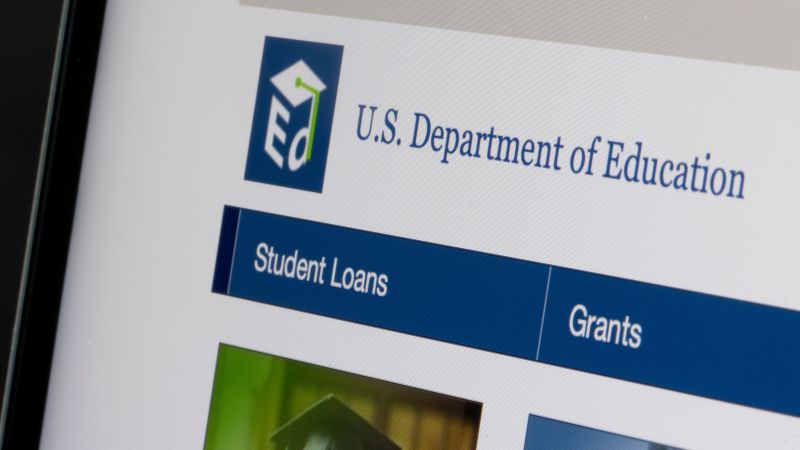
CNN
—
The Department of Education released a breakdown of federal student loan forgiveness applications by congressional district on Friday, providing a new window into the demographics of borrowers seeking relief across both Republican and Democratic-represented districts.
The new data is being released as the fate of President Joe Biden’s debt relief plan remains in limbo, with the US Supreme Court set to soon hear cases challenging its legality later this month. The initiative would offer up to $20,000 of individual debt forgiveness to millions of low- and middle-income borrowers, but ongoing legal challenges have meant that no one has received relief – including millions of borrowers whose applications have already been approved.
The White House says the plan is vital in order to provide targeted debt relief to certain federal student-loan borrowers affected by the Covid-19 pandemic. But many Republicans say that the relief will make inflation worse and argue it’s unfair to individuals who didn’t take out student loans or have already paid them off. They’ve also criticized the administration’s legal justification for issuing the relief through executive authority.
The Department of Education received about 26 million applications for debt relief by the time a federal district court judge blocked the program in November. More than 16 million of those borrowers’ applications were fully approved and more than 40 million borrowers would qualify for the program, according to the administration.
“Across the country, in every congressional district there is a strong desire for the Biden-Harris Administration’s one-time debt relief program,” a Department of Education official said about the new data. “In every single congressional district, at least half of eligible borrowers either applied or were deemed auto-eligible for debt relief, and that was only in the one month that the application was available before the program got blocked because of lawsuits.”
In every congressional district, the official said, at least 30% of eligible borrowers were approved to have their debt discharged before the program was blocked. Some 81% of all applications for relief came from the bottom 80% of congressional districts when broken down by average income, the official added.
A new Politico analysis of additional zip code data from the department obtained though a public records request also shows that borrowers living in lower-income areas applied for relief at a higher rate compared to those who live in wealthier neighborhoods, and most applications came from places where the per-capita income is under $35,000. Non-White majority zip codes accounted for more forgiveness applications per capita than majority-White zip codes.
Friday’s data build on earlier numbers released by the Department of Education which showed a state-by-state breakdown of student loan forgiveness applications, which were published shortly after independent auditors questioned the estimated cost of the program.
The the latest release coincides with the Supreme Court planning to hear two cases pertaining to Biden’s student loan forgiveness program later this month, including one from several Republican-led states.
Nebraska, Missouri, Arkansas, Iowa, Kansas and South Carolina say that the Department of Education did not have the legal authority to issue such a cancellation. They argue that it violates the separation of powers and that Biden is using the pandemic as a pretext to mask his true goal of fulfilling a campaign promise to erase student-loan debt.
They put forward several theories that they say allow them to get into court to challenge a program they argue unlawfully invokes Covid “to assert power beyond anything Congress could have conceived.”
Another case being heard by the high court this month was brought by two individual borrowers – Myra Brown and Alexander Taylor – who are not qualified for full debt relief forgiveness and who say they were denied an opportunity to comment on Education Secretary Miguel Cardona’s decision to provide targeted student loan debt relief to some.
Earlier this month, 126 House Republicans – led by Education and the Workforce Committee Chairwoman Virginia Foxx of North Carolina and South Carolina Rep. Jeff Duncan – filed an amicus brief opposing the debt forgiveness effort.
According to the White House data, in Foxx’s district, approximately 61% of borrowers, some 46,300 people, applied or were automatically eligible for relief. In Duncan’s district, about 59% of borrowers, 51,400 people, applied or were automatically eligible for relief.
A number of members in Republican leadership, including Majority Leader Steve Scalise, Majority Whip Tom Emmer, Conference Chair Elise Stefanik and Policy Committee Chair Gary Palmer also signed onto the brief.
House Speaker Kevin McCarthy did not sign onto the brief, but he has been critical of the president’s plan.
McCarthy’s home state of California, the most populous state in the nation, has 2.3 million people who have applied or were automatically eligible for relief – the most out of any state. Approximately 60% of borrowers in the speaker’s district applied or were automatically eligible for relief, with 31,600 borrowers already fully approved for relief out of 49,800 who have applied or were automatically eligible.
Representatives for Foxx, Duncan, Scalise, Emmer, Stefanik, Palmer and McCarthy did not respond to CNN’s request for comment on the new data.

